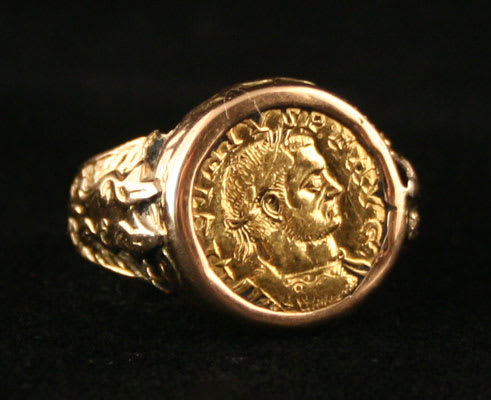Classical Revival Gold Ring Featuring a Gold Coin of Emperor Licinius, 18th Century CE - 19th Century CE
Gold
FJ.7173
Both the silver setting and the gold coin date to the Classical Revival period, evoking the Ancient Roman style. Born of Illyrian peasant stock, Licinius advanced in the army and...
Both the silver setting and the gold coin date to the Classical Revival period, evoking the Ancient Roman style.
Born of Illyrian peasant stock, Licinius advanced in the army and was suddenly elevated to the rank of Augustus by his friend, Emperor Galerius. Galerius hoped to have him rule the West, but since Italy, Africa, and Spain were held by the usurper Maxentius, while Constantine reigned in Gaul and Britain, Licinius had to content himself with ruling Pannonia. When Galerius died in 311, Licinius took over Galerius' European dominions. In 313, he married Constantine's half sister Constantia and defeated the Eastern emperor Maximinus who shortly thereafter died. Licinius thus added the entire eastern half of the empire to his dominion. During the campaign against Maximinus, Licinius had made his army use a monotheistic form of prayer closely resembling that later imposed by Constantine. On June 5, 313, he had issued an edict granting tolerance to the Christians and restoring church property.
Born of Illyrian peasant stock, Licinius advanced in the army and was suddenly elevated to the rank of Augustus by his friend, Emperor Galerius. Galerius hoped to have him rule the West, but since Italy, Africa, and Spain were held by the usurper Maxentius, while Constantine reigned in Gaul and Britain, Licinius had to content himself with ruling Pannonia. When Galerius died in 311, Licinius took over Galerius' European dominions. In 313, he married Constantine's half sister Constantia and defeated the Eastern emperor Maximinus who shortly thereafter died. Licinius thus added the entire eastern half of the empire to his dominion. During the campaign against Maximinus, Licinius had made his army use a monotheistic form of prayer closely resembling that later imposed by Constantine. On June 5, 313, he had issued an edict granting tolerance to the Christians and restoring church property.



